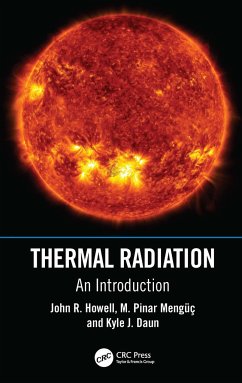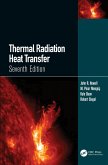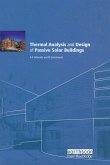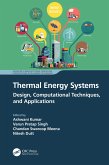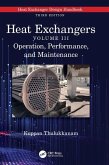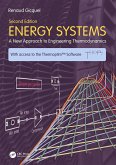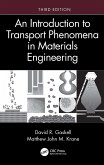John R. Howell (USA The University of Texas at Austin), M. Pinar Menguc (Ozyegin Universities, Istanbul, Turkey), Kyle J. Daun (University of Waterloo, Waterloo, Canada)
Thermal Radiation
An Introduction
John R. Howell (USA The University of Texas at Austin), M. Pinar Menguc (Ozyegin Universities, Istanbul, Turkey), Kyle J. Daun (University of Waterloo, Waterloo, Canada)
Thermal Radiation
An Introduction
- Gebundenes Buch
- Merkliste
- Auf die Merkliste
- Bewerten Bewerten
- Teilen
- Produkt teilen
- Produkterinnerung
- Produkterinnerung
The book is a complete text for a one-semester introductory graduate course on radiative energy transfer. It covers radiative transfer among surfaces, with an introduction to the effects of participating media between surfaces, surface and medium property characteristics, and solution of the radiative transfer equation in simple geometries.
Andere Kunden interessierten sich auch für
![Thermal Radiation Heat Transfer Thermal Radiation Heat Transfer]() John R. HowellThermal Radiation Heat Transfer138,99 €
John R. HowellThermal Radiation Heat Transfer138,99 €![Thermal Analysis and Design of Passive Solar Buildings Thermal Analysis and Design of Passive Solar Buildings]() AK AthienitisThermal Analysis and Design of Passive Solar Buildings49,99 €
AK AthienitisThermal Analysis and Design of Passive Solar Buildings49,99 €![Analytical Heat Transfer Analytical Heat Transfer]() Je-Chin HanAnalytical Heat Transfer158,99 €
Je-Chin HanAnalytical Heat Transfer158,99 €![Thermal Energy Systems Thermal Energy Systems]() Thermal Energy Systems182,99 €
Thermal Energy Systems182,99 €![Heat Exchangers Heat Exchangers]() Kuppan Thulukkanam ( Indian Railway Service of Mechanical EngineersHeat Exchangers215,99 €
Kuppan Thulukkanam ( Indian Railway Service of Mechanical EngineersHeat Exchangers215,99 €![Energy Systems Energy Systems]() Renaud GicquelEnergy Systems81,99 €
Renaud GicquelEnergy Systems81,99 €![An Introduction to Transport Phenomena in Materials Engineering An Introduction to Transport Phenomena in Materials Engineering]() David R. GaskellAn Introduction to Transport Phenomena in Materials Engineering122,99 €
David R. GaskellAn Introduction to Transport Phenomena in Materials Engineering122,99 €-
-
-
The book is a complete text for a one-semester introductory graduate course on radiative energy transfer. It covers radiative transfer among surfaces, with an introduction to the effects of participating media between surfaces, surface and medium property characteristics, and solution of the radiative transfer equation in simple geometries.
Hinweis: Dieser Artikel kann nur an eine deutsche Lieferadresse ausgeliefert werden.
Hinweis: Dieser Artikel kann nur an eine deutsche Lieferadresse ausgeliefert werden.
Produktdetails
- Produktdetails
- Verlag: Taylor & Francis Ltd
- Seitenzahl: 450
- Erscheinungstermin: 20. März 2023
- Englisch
- Abmessung: 237mm x 162mm x 29mm
- Gewicht: 846g
- ISBN-13: 9781032015316
- ISBN-10: 1032015314
- Artikelnr.: 66267237
- Herstellerkennzeichnung
- Libri GmbH
- Europaallee 1
- 36244 Bad Hersfeld
- gpsr@libri.de
- Verlag: Taylor & Francis Ltd
- Seitenzahl: 450
- Erscheinungstermin: 20. März 2023
- Englisch
- Abmessung: 237mm x 162mm x 29mm
- Gewicht: 846g
- ISBN-13: 9781032015316
- ISBN-10: 1032015314
- Artikelnr.: 66267237
- Herstellerkennzeichnung
- Libri GmbH
- Europaallee 1
- 36244 Bad Hersfeld
- gpsr@libri.de
John R. (Jack) Howell received his academic degrees from Case Western Reserve University (then Case Institute of Technology), Cleveland, Ohio. He began his engineering career as a researcher at NASA Lewis (now Glenn) Research Center (1961-1968) and then took academic positions at the University of Houston (1978-1988) and the University of Texas at Austin, where he remained until retirement in 2012. He is presently Ernest Cockrell, Jr., Memorial Chair Emeritus. He pioneered the use of the Monte Carlo method for the analysis of radiative heat transfer in complex systems that contain absorbing, emitting, and scattering media. Jack has concentrated his research on computational techniques for radiative transfer and combined-mode problems for over 60 years. Recently, he has adapted inverse solution techniques to combined-mode problems and to radiation at the nanoscale. His awards in heat transfer include the ASME/AIChE Max Jakob Medal (1998), ASME Heat Transfer Memorial Award (1991), AIAA Thermophysics Award (1990), the Poynting Award from JQSRT (2013) and the 2018 International Center for Heat and Mass Transfer Luikov Medal. He is an elected member of the U.S. National Academy of Engineering (2005) and a foreign member of the Russian Academy of Sciences (1999). He is an Honorary Fellow of the American Society of Mechanical Engineering (ASME). M. Pinar Mengüç completed his BSc and MS in mechanical engineering from the Middle East Technical University (METU) in Ankara, Turkey. He earned his PhD in mechanical engineering from Purdue University in 1985. He joined the faculty at the University of Kentucky the same year and was promoted to the ranks of associate and full professor in 1988 and 1993, respectively. In 2008, he was named an Engineering Alumni Association professor. Later that year, he joined Özyegin University in Istanbul as the founding head of the Mechanical Engineering Department. In 2009 he established the Center for Energy, Environment, and Economy (CEEE), which he still directs. Kyle Daun received his BSc from the University of Manitoba (1997), his MASc from the University of Waterloo (1999), and his PhD from the University of Texas at Austin (2003). From 2004 to 2007, he worked at the National Research Council Canada as a Natural Sciences and Engineering Research Council of Canada postdoctoral fellow and later as a research officer. While at NRC, he investigated radiation heat transfer in solid oxide fuel cells and helped develop and improve laser-based combustion diagnostics. In 2007, he returned to the University of Waterloo, where he is now a Professor in the Department of Mechanical and Mechatronics Engineering. Professor Daun's research interests include inverse problems in radiative transfer, laser-based combustion diagnostics, nanoscale transport phenomena, and heat transfer in manufacturing. He has published over 250 contributions, including 90 refereed journal papers. Professor Daun is a fellow of the Humboldt Foundation, a DFG Mercator Fellow, and a Fellow of the American Society of Mechanical Engineering. In 2010, he received the JQSRT Ray Viskanta Young Scientist Award.
1. Why Study Radiation Energy Transfer? 2. The Basics of Thermal
Radiation. 3. Radiative Properties at Interfaces. 4. Predicted and
Measured Surface Properties. 5. Configuration Factors for Diffuse
Surfaces. 6. Radiation Exchange in Enclosures Bounding Transparent Media.
7. Radiation Combined with Boundary Conduction and Convection. 8.
Properties of Participating Media. 9. Radiative Transfer in Participating
Media. 10. Numerical methods for radiative transfer problems. 11.
Radiation in Solids, Windows, and Coatings. 12. Emerging Areas. Appendix.
Radiation Constants and Blackbody Functions.
Radiation. 3. Radiative Properties at Interfaces. 4. Predicted and
Measured Surface Properties. 5. Configuration Factors for Diffuse
Surfaces. 6. Radiation Exchange in Enclosures Bounding Transparent Media.
7. Radiation Combined with Boundary Conduction and Convection. 8.
Properties of Participating Media. 9. Radiative Transfer in Participating
Media. 10. Numerical methods for radiative transfer problems. 11.
Radiation in Solids, Windows, and Coatings. 12. Emerging Areas. Appendix.
Radiation Constants and Blackbody Functions.
1. Why Study Radiation Energy Transfer? 2. The Basics of Thermal
Radiation. 3. Radiative Properties at Interfaces. 4. Predicted and
Measured Surface Properties. 5. Configuration Factors for Diffuse
Surfaces. 6. Radiation Exchange in Enclosures Bounding Transparent Media.
7. Radiation Combined with Boundary Conduction and Convection. 8.
Properties of Participating Media. 9. Radiative Transfer in Participating
Media. 10. Numerical methods for radiative transfer problems. 11.
Radiation in Solids, Windows, and Coatings. 12. Emerging Areas. Appendix.
Radiation Constants and Blackbody Functions.
Radiation. 3. Radiative Properties at Interfaces. 4. Predicted and
Measured Surface Properties. 5. Configuration Factors for Diffuse
Surfaces. 6. Radiation Exchange in Enclosures Bounding Transparent Media.
7. Radiation Combined with Boundary Conduction and Convection. 8.
Properties of Participating Media. 9. Radiative Transfer in Participating
Media. 10. Numerical methods for radiative transfer problems. 11.
Radiation in Solids, Windows, and Coatings. 12. Emerging Areas. Appendix.
Radiation Constants and Blackbody Functions.

